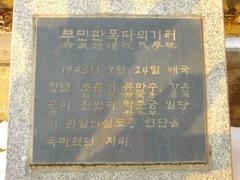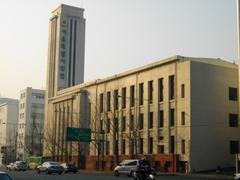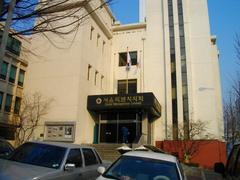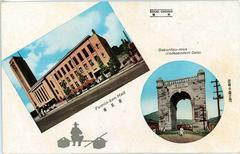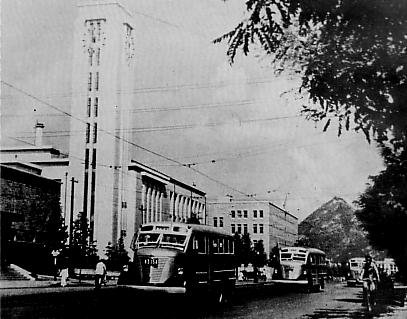
Bumingwan Visiting Hours, Tickets, and Tourist Guide for Seoul Historical Sites
Date: 15/06/2025
Introduction: The Historical Resonance of Bumingwan in Seoul
Nestled in the heart of Seoul, Bumingwan (부민관; 府民館) stands as a monumental testament to Korea’s tumultuous journey through colonial rule, liberation, and the development of modern democracy. Completed in 1935 during the Japanese occupation, this neoclassical building initially served as a cultural and governmental hub, symbolizing both the colonial administration’s vision and the aspirations of the local populace. Over time, Bumingwan evolved into a site of resistance, a cradle for Korea’s post-liberation government, and now, the seat of the Seoul Metropolitan Council. Its layered history and striking architecture offer visitors a compelling narrative of Korea’s political and urban transformation (minksunghertiage.com, Wikipedia, Seoul Metropolitan Government, Chosun Architecture).
This guide provides all the essential information you need to visit Bumingwan, including visiting hours, ticketing, accessibility, travel tips, and nearby attractions. Whether you are a history enthusiast, an architecture lover, or a cultural traveler, Bumingwan is a must-see for anyone wanting to understand Seoul’s layered past and resilient spirit.
Table of Contents
- Bumingwan’s Origins and Construction
- Role During the Japanese Colonial Period
- Bumingwan Bombing and Independence Movement
- Post-Liberation and National Assembly Era
- Architectural and Cultural Legacy
- Visitor Information: Hours, Tickets, Accessibility
- Travel Tips and Nearby Attractions
- Visitor FAQs
- Summary and Practical Advice
- References
Bumingwan’s Origins and Construction
Located at 110 Sejong-daero, Jung-gu, Seoul, Bumingwan was built between 1934 and 1935 under Japanese colonial rule. It was envisioned as a modern multi-purpose facility, boasting a three-story structure with a basement, a large auditorium seating 1,800, smaller halls, and amenities such as a restaurant and barbershop. The building was equipped with state-of-the-art heating and ventilation for its time (minksunghertiage.com).
The original purpose was to serve both the Japanese and Korean communities, symbolizing a forced cultural integration. Its architecture, blending neoclassical elements with functional modernism, reflected the ambitions of the era (Chosun Architecture).
Role During the Japanese Colonial Period
Bumingwan quickly became a focal point for public performances, official ceremonies, and government propaganda. The venue hosted cultural events, lectures, and mobilization rallies, especially during the Second Sino-Japanese War. Koreans saw it as a symbol of colonial oppression, and it was frequently targeted by independence activists (minksunghertiage.com).
Bumingwan Bombing and Independence Movement
On July 24, 1945, just weeks before Korea’s liberation, Jo Munki of the Korean Patriotic Party attempted to bomb Bumingwan during a pro-Japanese conference. Though unsuccessful in causing mass casualties, the incident underscored the building’s association with colonial power and the fervor of Korea’s independence movement. Today, a commemorative marker stands on-site (Wikipedia, Korea JoongAng Daily).
Post-Liberation and National Assembly Era
After liberation in August 1945, Bumingwan became a headquarters for the United States Army Military Government and the Seoul Metropolitan Government. It housed the National Theater Company of Korea until the Korean War. From 1954 to 1975, the building served as the National Assembly’s meeting hall, witnessing pivotal moments in Korean political history, including heated debates and dramatic parliamentary incidents (artsandculture.google.com). Since 1991, it has been the home of the Seoul Metropolitan Council (Wikipedia).
Architectural and Cultural Legacy
Bumingwan’s neoclassical façade, symmetrical layout, and large assembly halls exemplify 1930s modern architecture in Korea. At its completion, it was Seoul’s largest and most advanced cultural facility, seating more than 2,300 people. The building is recognized as Registered Cultural Heritage No. 11, underscoring its historical and architectural importance (minksunghertiage.com).
Its layered history—from colonial propaganda site to a symbol of democracy—mirrors Korea’s struggle and transformation throughout the 20th century.
Visitor Information: Hours, Tickets, Accessibility
Location
- Address: 125 Seosomun-ro, Jung-gu, Seoul, South Korea (world.seoul.go.kr)
Visiting Hours
- Standard Access: Monday to Friday, 9:00 AM to 6:00 PM. Closed on weekends and public holidays. As it is a working government building, access may be restricted without prior arrangement.
- Public Events/Guided Tours: Interior access is typically limited to official events or scheduled tours. Check the Seoul Metropolitan Council’s official website for event and tour dates.
Tickets
- Admission: Free for all visitors during public events or tours; advance booking required for guided tours.
Accessibility
- Subway: City Hall Station (Lines 1 and 2), Exit 5 or 8
- Bus: Multiple city buses stop at City Hall/Seoul Plaza
- Wheelchair Access: Ramps, elevators, and accessible restrooms available (Agoda)
Facilities
- Restrooms: Available inside and at Seoul Plaza
- Information Desks: Multilingual staff during events
- Cafés/Shops: Numerous options around City Hall and Seoul Plaza
Travel Tips and Nearby Attractions
Best Time to Visit
- Spring (April–June) and Autumn (September–November): Ideal weather for sightseeing and outdoor exploration.
- Event Days: Plan your visit during open house events or Seoul Citizens’ Day for rare interior access.
Nearby Historical Sites
- Deoksugung Palace: Directly across the street, known for its stone-wall road and guard changing ceremony (All About Seoul).
- Cheonggyecheon Stream: A scenic restored stream perfect for strolls.
- Gwanghwamun Square: Major public square with historical monuments.
- Seoul Plaza: Hosts seasonal events and festivals.
- Seoul Metropolitan Library and Seoul Museum of Art: Both housed in colonial-era buildings (Chosun Architecture).
Practical Tips
- Photography: Permitted outside and in public areas; restrictions may apply inside, especially during official sessions.
- Security: Expect bag checks and bring photo ID.
- Language: Most signage in Korean and English.
- Mobile Apps: Use KakaoMap, Naver Map, or Papago for navigation and translation.
Visitor FAQs
Q: What are Bumingwan’s visiting hours?
A: Public access is generally available Monday to Friday, 9:00 AM to 6:00 PM, mainly during guided tours or events.
Q: Is there an admission fee?
A: No, entry is free during public events and guided tours.
Q: How can I join a guided tour?
A: Reserve in advance through the Seoul Metropolitan Council website or contact the city’s tourism office.
Q: Is Bumingwan wheelchair accessible?
A: Yes, with ramps, elevators, and accessible restrooms.
Q: What other sites are nearby?
A: Deoksugung Palace, Cheonggyecheon Stream, Gwanghwamun Square, Seoul Plaza, and the Seoul Museum of Art.
Summary and Practical Advice
Bumingwan is an essential landmark for understanding Seoul’s layered history and vibrant civic culture. From its origins as a colonial-era cultural center to its present role as the home of the Seoul Metropolitan Council, it encapsulates Korea’s journey toward democracy and modernity. Visitors are encouraged to check for open house events or guided tours to access the interior, and to explore surrounding landmarks for a comprehensive experience of Seoul’s heritage.
For real-time updates, ticket booking, and detailed event information, consult the official resources listed below and consider downloading the Audiala app for enhanced travel planning. Experience the living history of Seoul at Bumingwan and immerse yourself in the stories that have shaped modern Korea.
References
- Old Seoul National Assembly Building - Min Sung Heritage
- Bumingwan - Wikipedia
- Exploring Bumingwan: A Must-Visit Seoul Historical Site - World Seoul
- Architecture of Seoul 1905-1945 - Chosun Architecture
- 2025 Seoul Tourist Map - Seoul Metropolitan Government
- Bomb-site remains landmark of independence movement - Korea JoongAng Daily
- Cultural Events at Bumingwan - NextStopKorea
- South Korea Tourism and Political Landscape - Travel and Tour World
- Bumingwan Accessibility and Visitor Information - Agoda Travel Guide

